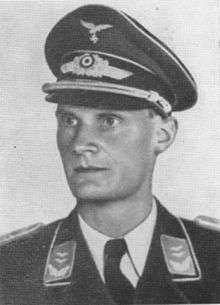Harro Schulze-Boysen

Heinz Harro Max Wilhelm Georg Schulze-Boysen (2 September 1909 – 22 December 1942) was a German soldier who would become a leading figure in the Red Orchestra (Rote Kapelle) group in the German resistance to Nazism during World War II. He was arrested and executed in 1942.
Early life
Schulze-Boysen was born in Kiel as the son of decorated naval officer Erich Edgar Schulze. His mother was Marie Luise (née Boysen). On his father's side, he also counted Grand Admiral Alfred von Tirpitz among his kin. He had a sister, Helga (born 1910) and brother, Hartmut (born 1922).
He spent his youth in Duisburg. In 1923, when he was 14, he found himself in the middle of the occupation of the Ruhr by French and Belgian troops. Schulze-Boysen's participation in the struggle against the occupiers brought about his swift arrest by the French.
Political activities
In 1928, he joined the Jungdeutscher Orden, a youth organization in the Weimar Republic and the Studentenverbindung Albingia. He studied law in Freiburg (Baden-Württemberg), and Berlin, without finishing. In 1930, he supported an intellectual-nationalistic group called the Volksnationale Reichsvereinigung ("People's National Imperial Union"), had contacts with the French magazine Plans in 1931, which sought the establishment of a Europe-wide collective economic system. The same year, he published the left-liberal Der Gegner founded by Franz Jung and modelled on Plans. Although he was leaning towards the political left, he maintained his contacts with nationalistic circles.
In 1932, he organized the Treffen der revolutionären Jugend Europas ("Meeting of Europe's Revolutionary Youth"), with over a hundred participants. He also advocated the abolition of the capitalist system, and the liquidation of the Diktat of Versailles.
In April 1933, the offices of Der Gegner were destroyed by Brown Shirt thugs, and Schulze-Boysen was roughed up, had swastikas scratched in his skin, and was held in confinement for several days. He was released after his parents intervened. In May 1933 he began pilot training at Warnemünde and from 1934 he was working in the communications department of the Reich Air Transport Ministry (Reichsluftfahrtministerium) in Berlin.
Resistance activities
Beginning in 1935, he gathered around himself a circle of left-leaning anti-fascists, among them artists, pacifists, and Communists. The circle published anti-fascist writings. In 1936, he married Libertas Haas-Heye, a press officer for Metro-Goldwyn-Mayer, who likewise joined the resistance group. In 1936, Schulze-Boysen made contact with Arvid Harnack and his circle, and also with the Communists Hilde and Hans Coppi. From these meetings arose what the Gestapo called the Red Orchestra (Rote Kapelle) group.
In 1940-1941, the group was in wireless contact with Soviet agents, and was thereby trying to thwart the forthcoming German aggression upon the Soviet Union. (As a first lieutenant on the Luftwaffe Leadership Staff, Schulze-Boysen had access to secret documents.)
Arrest and death
In July 1942, the Decryption Department of the Oberkommando des Heeres managed to decode the group's radio messages, and the Gestapo pounced. On 31 August, Harro and Libertas Schulze-Boysen were arrested. They were sentenced to death on 19 December and executed three days later at Plötzensee Prison in Berlin. Their bodies were released to Hermann Stieve, an anatomist at what is now Humboldt University, to be dissected for research. Their final resting place is not known.
Memorials
In the Berlin borough of Lichtenberg in 1972, a street is named after the Schulze-Boysens (see link below). There are stolpersteine for them in the Dellviertel quarter of Duisburg, at Karl-Lehr-Straße 9.[1]
In the picture at right appear the following lines:
- "Wenn wir auch sterben sollen,
- So wissen wir: Die Saat
- Geht auf. Wenn Köpfe rollen, dann
- Zwingt doch der Geist den Staat."
- "Glaubt mit mir an die gerechte Zeit, die alles reifen lässt!"
- "Even if we should die,
- We know this: The seed
- Bears fruit. If heads roll, then
- The spirit nevertheless forces the state."
- "Believe with me in the just time that lets everything ripen."
References
- ↑ Jenny Bünnig and Kurt Walter, "Stolpersteine in Duisburg“ Band II" (PDF) Evangelischer Kirschenkreis Duisburg, Evangelisches Familienbildungswerk (2009), page 45. Retrieved June 21, 2010 (German)
Sources
- Harro Schulze-Boysen: Gegner von heute – Kampfgenossen von morgen. (Erstauflage 1932); Fölbach Verlag, Koblenz 1994, 4. Auflage ISBN 3-923532-24-5
- Elsa Boysen: Harro Schulze-Boysen – Das Bild eines Freiheitskämpfers. (Erstauflage 1947), Fölbach Verlag, Koblenz 1992, ISBN 3-923532-17-2
- Shareen Blair Brysac: Mildred Harnack und die „Rote Kapelle“. Die Geschichte einer ungewöhnlichen Frau und einer Widerstandsbewegung. Scherz-Verlag, Bern 2003, ISBN 3-502-18090-3
- Hans Coppi: Harro Schulze-Boysen – Wege in den Widerstand, Fölbach Verlag, Koblenz 1995, 2. Auflage, ISBN 3-923532-28-8
- Hans Coppi: Harro Schulze-Boysen und Alexandre Marc. Die Gruppe Ordre Nouveau und der Gegner-Kreis. Oder: Der Versuch, die deutsch-französischen Beziehungen auf neue Grundlagen zu stellen. In: Ferdinand Kinsky / Franz Knipping (Hrsg.): Le fédéralisme personnaliste aux sources de l'Europe de demain. Der personalistische Föderalismus und die Zukunft Europas. Schriftenreihe des Europäischen Zentrums für Föderalismus-Forschung Tübingen, Band 7. Nomos Verlagsgesellschaft: Baden-Baden 1996 S. 153–167
- Hans Coppi, Geertje Andresen (Hrsg.): Dieser Tod paßt zu mir. Harro Schulze-Boysen - Grenzgänger im Widerstand. Briefe 1915-1942, Aufbau Taschenbuch Verlag, Berlin 2002, ISBN 3-7466-8093-X
- Alexander Bahar: Sozialrevolutionärer Nationalismus zwischen Konservativer Revolution und Sozialismus – Harro Schulze-Boysen und der GEGNER-Kreis. Fölbach Verlag, Koblenz 1992, ISBN 978-3-923532-18-6
- Silke Kettelhake: Erzähl allen, allen von mir! Droemer Knaur, 2008. 432 Seiten. ISBN 3-426-27437-X (Biographie der Ehefrau)
- Karl Otto Paetel: Nationalbolschewismus und nationalrevolutionaere Bewegungen in Deutschland. „Der Gegnerkreis“ S.189 bis S.205, Verlag Siegfried Bublies, Schnellbach 1999, ISBN 3-926584-49-1
- Gert Rosiejka: Die Rote Kapelle. „Landesverrat“ als antifaschistischer Widerstand. – Mit einer Einführung von Heinrich Scheel. ergebnisse, Hamburg 1986, ISBN 3-925622-16-0
External links
- Harro Schulze-Boysen in the German National Library catalogue
- Lebendiges Museum Online (German)
- Berlingeschichte.de: Schulze-Boysen-Straße (German)